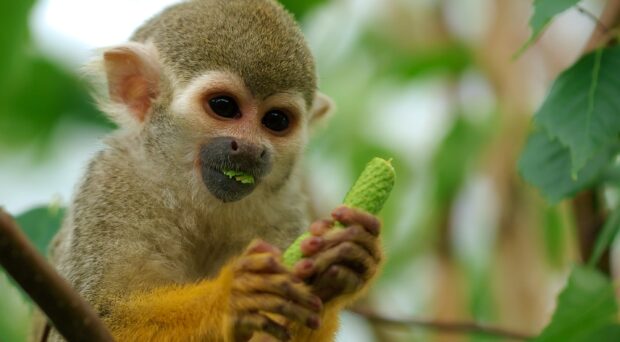
Monkeys are very susceptible to Toxoplasma gondii infections, and for squirrel monkeys (Saimiri species) toxoplasmosis is often fatal. The reason for this seems to be linked to the evolution of New World Primates and the lack of co-evolution with T. gondii.
Toxoplasma and monkeys
T. gondii is a feline parasite. The definitive hosts are both wild and domesticated felids, but it also has an amazing ability to infect almost any animal to act as an intermediate host, making it a worryingly ubiquitous parasite. Animals that have co-evolved with felids and T. gondii do not ordinarily exhibit acute disease (although immunosuppressed animals do, and T. gondii is dangerous in such cases and of course T. gondii is a dangerous infection during pregnancy). However, New World Primates evolved more than 20 million years before felids, therefore a long time before T. gondii entered the scene in the Americas. In addition, the tree-top life of squirrel monkeys means they are rarely exposed to this pervasive parasite, preventing any adaptation of their immune system to T. gondii.
For zoos, outbreaks of fatal toxoplasmosis in simians are devastating, sometimes taking out over 50% of their captive colonies. Sadly, it is all too easy for T. gondii oocysts to find their way into squirrel monkey enclosures, as they can be transported in by cockroaches, or humans or even cysts in small prey.
Currently there is only one commercially available vaccine that protects from toxoplasmosis. This vaccine protects sheep and helps prevent aborted foetuses. However, this is a live attenuated vaccine which is not suitable to highly susceptible species such as squirrel monkeys.
Another vaccine candidate, the DGNP/TE vaccine, has been developed which has shown promise but had not yet been tested on squirrel monkeys, until recently. Several French zoos, which were facing potentially very heavy losses to their squirrel monkey colonies, volunteered to test out this vaccine and, due to the lack of treatment or intervention for toxoplasmosis in simians, such a study was authorised under European directives and French regulations.
This was a golden opportunity for researchers to test the vaccine’s safety and to study the immune responses induced by the vaccine in this highly susceptible species with the findings reported in this article.
Vaccines and Tests
Before vaccination, all monkeys were tested for T. gondii antibodies using the High Sensitivity Direct Agglutination (HSDA) test. Five were found to be seropositive for T. gondii and were not vaccinated, to act as positive controls. In total forty-eight squirrel monkeys (Saimiri boliviensis; 28 females and 20 males aged 8 ± 6 years) housed across six French Zoos were vaccinated.
In addition to these, sixteen naive squirrel monkeys (Saimiri sciureus; 13 females and three males, aged 13.5 ± 3.3 years) from the Mediterranean Primatology Center (MPRC) free from any infectious disease were housed in a level I and II containment enclosure.
All seronegative monkeys were given the vaccine using a specially adapted protocol for intranasal administration. Two doses were given one month apart, and a third dose was given 6 months later as a combined intranasal and subcutaneous administered dose. An annual and 2-year booster was given using combined intranasal and subcutaneous dose.
For the immunological study 21 adult monkeys from four zoos were tested. Each monkey was examined before and after each vaccination for any physiological changes, reactions or side effects and faecal and blood samples were collected for the immunological testing. The researchers tested for:
- IgA and IgG in faeces of squirrel monkeys before and after vaccination at day 0 and 6, 12, and 24 months after vaccination – none were detected.
- IgA and IgG in sera before and 6, 12, and 24 months after vaccination and compared to naturally infected monkeys – the results were not significantly different.
- The neutralising activity of sera from vaccinated squirrel monkeys – the researchers showed that sera of vaccinated squirrel monkeys inhibited the multiplications of T. gondii by varying percentages that increased as time passed from first vaccination.
- Cellular immune responses – IFN-y mediated TH1 increased over time after full vaccination and approached level of naturally infected squirrel monkeys. IL-17 was significantly higher 1 year after full vaccination and higher than naturally infected squirrely monkeys.
- Pattern recognition receptors. The researchers concluded that both toll-like and nod-like receptors (TLRs and NLRs) were involved in T. gondii recognition.
A hopeful story for the monkeys and for all animals
The study reported that there was no localized reaction to the nasal or subcutaneous administration of the vaccine, or any general reaction after vaccination. Even better, there have been, so far, no deaths due to toxoplasmosis in these squirrel monkeys since their vaccination, now over 4 years ago. This contrasts with the previous 8 years where zoos had reported reoccurring outbreaks, some recording between 1 to 15 deaths per year.
Fingers crossed this can now be used as a new intervention to protect highly susceptible species such as squirrel monkeys from toxoplasmosis and may even offer potential vaccination candidates to protect others species from toxoplasmosis, including humans.

Comments